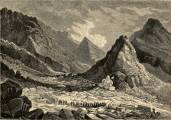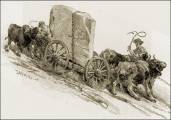


From Quarry to Cemetery Stone
Principal Varieties of Materials Used for Cemetery Markers
Many types of materials have were used as cemetery markers in early California: Wood, field stones, sandstone, marble, granite, slate, zinc, white bronze, sheet metal, and cement. Below are some examples of markers created from these materials.
Stone & Wooden Markers
Below is are two examplex of the use of a fieldstone as a cemetery marker:
Here is a photograph of an old wooden cemetery marker:
Slate Markers
While slate was used extensively in the eastern states for cemetery monuments, there are relatively few slate monuments found in the old California cemeteries.
The following photographs are of the back and front of one of the few slate cemetery markers that I’ve found in California cemeteries:
Sandstone Markers
These four photographs shows the color variations in the Winters sandstone located in the Winters Cemetery in Winters, Yolo County, California.
The next four photographs shows the color variations in the Benicia sandstone, although the sandstone quarried on the Benicia Arsenal grounds is a more constant light brown.
(All of the following sandstone photographs were taken in the Benicia City Cemetery in Solano County.)
Marble Markers
These photographs are all of marble cemetery stones. The first two are of white marble. The second is a bluish-gray marble with some white. Many of the old white marble cemetery stones have discolored over time due to environmental causes such as lichen, droppings from trees, and high mineral content in the water used to water the plantings.
Granite Markers
Gray granite was used for many of the early granite cemetery stones. Later people started used colored granites such as the photographs below.
Metal Markers
These metal markers are called by various names, and it’s a subject that I’m not well versed in yet. The buyer could choose among many styles and many panel patterns that were available. These metal markers have generally aged better in our cemeteries than the sandstone and marble cemetery stones. They were referred to under various names such as: Zinc, white bronze, and sheet metal.
Commercial use of material within this site is strictly prohibited. It is not to be captured, reworked, and placed inside another web site ©. All rights reserved. Peggy B. and George (Pat) Perazzo.


























